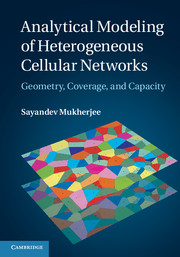Book contents
- Frontmatter
- Contents
- Preface
- Acknowledgemants
- List of notation
- List of acronyms and abbreviations
- 1 Introduction
- 2 Structure of the SINR calculation problem
- 3 Poisson point processes
- 4 SINR analysis for a single tier with fixed power
- 5 SINR analysis for multiple tiers with fixed powers
- 6 SINR analysis with power control
- 7 Spectral and energy efficiency analysis
- 8 Closing thoughts: future heterogeneous networks
- Appendix A Some common probability distributions
- Appendix B HCNs in LTE
- References
- Author index
- Subject index
3 - Poisson point processes
Published online by Cambridge University Press: 18 December 2013
- Frontmatter
- Contents
- Preface
- Acknowledgemants
- List of notation
- List of acronyms and abbreviations
- 1 Introduction
- 2 Structure of the SINR calculation problem
- 3 Poisson point processes
- 4 SINR analysis for a single tier with fixed power
- 5 SINR analysis for multiple tiers with fixed powers
- 6 SINR analysis with power control
- 7 Spectral and energy efficiency analysis
- 8 Closing thoughts: future heterogeneous networks
- Appendix A Some common probability distributions
- Appendix B HCNs in LTE
- References
- Author index
- Subject index
Summary
This chapter will serve as a quick review of the essential results in the theory of Poisson point processes (PPPs) that we shall use for our analysis later in the book. However, we shall first take a step back and discuss point processes in general and their applicability to our wireless deployments of interest. Then we shall provide arguments in support of the use of Poisson point processes before summarizing the most important mathematical results. This chapter is not meant to be an exhaustive treatment of the theory of PPPs – for that, see Kingman (1993). The principal theorems will be quoted with citations only to appropriate references, but heuristic arguments will be provided to help the reader understand them.
Stochastic models for BS locations
In this book, we restrict ourselves to BS deployments on a plane, i.e. in two dimensions. This models many scenarios of interest, but not all, e.g. low-power BSs (“access points”) mounted indoors on several floors of an office building. Nonetheless, the theory in two dimensions is rich enough to yield useful results for a number of practical scenarios, and the techniques we employ to derive these results in this book can be extended straightforwardly to three dimensions.
A plot of the locations of the BSs in such a deployment is a so-called “spatial point pattern,” or “point pattern” for short. In practice, network operators spend enormous amounts of time and resources on finding the best locations for their BS sites, taking into account such factors as the traffic they expect to support, geographical obstacles and features, municipal laws and zoning permissions, etc.
- Type
- Chapter
- Information
- Analytical Modeling of Heterogeneous Cellular NetworksGeometry, Coverage, and Capacity, pp. 23 - 34Publisher: Cambridge University PressPrint publication year: 2014



